MBA401: Crisis Management & Leadership Styles at Woolworths
VerifiedAdded on 2023/03/30
|12
|895
|130
Report
AI Summary
This report examines Woolworths' organizational crisis, its potential consequences, and the application of different leadership styles, particularly transformational leadership, in managing the crisis. It discusses the advantages and disadvantages of transformational leadership, recommending a strategy consistent with political conditions, fair pricing, and continuous innovation. The analysis concludes that external environmental factors negatively affect Woolworths' strategy and growth, emphasizing the need for strategic change management for long-term improvement and profitability. Desklib offers similar resources for students.

Woolworths
Supermarkets
Australia
MANAGEMENT
Supermarkets
Australia
MANAGEMENT
Paraphrase This Document
Need a fresh take? Get an instant paraphrase of this document with our AI Paraphraser
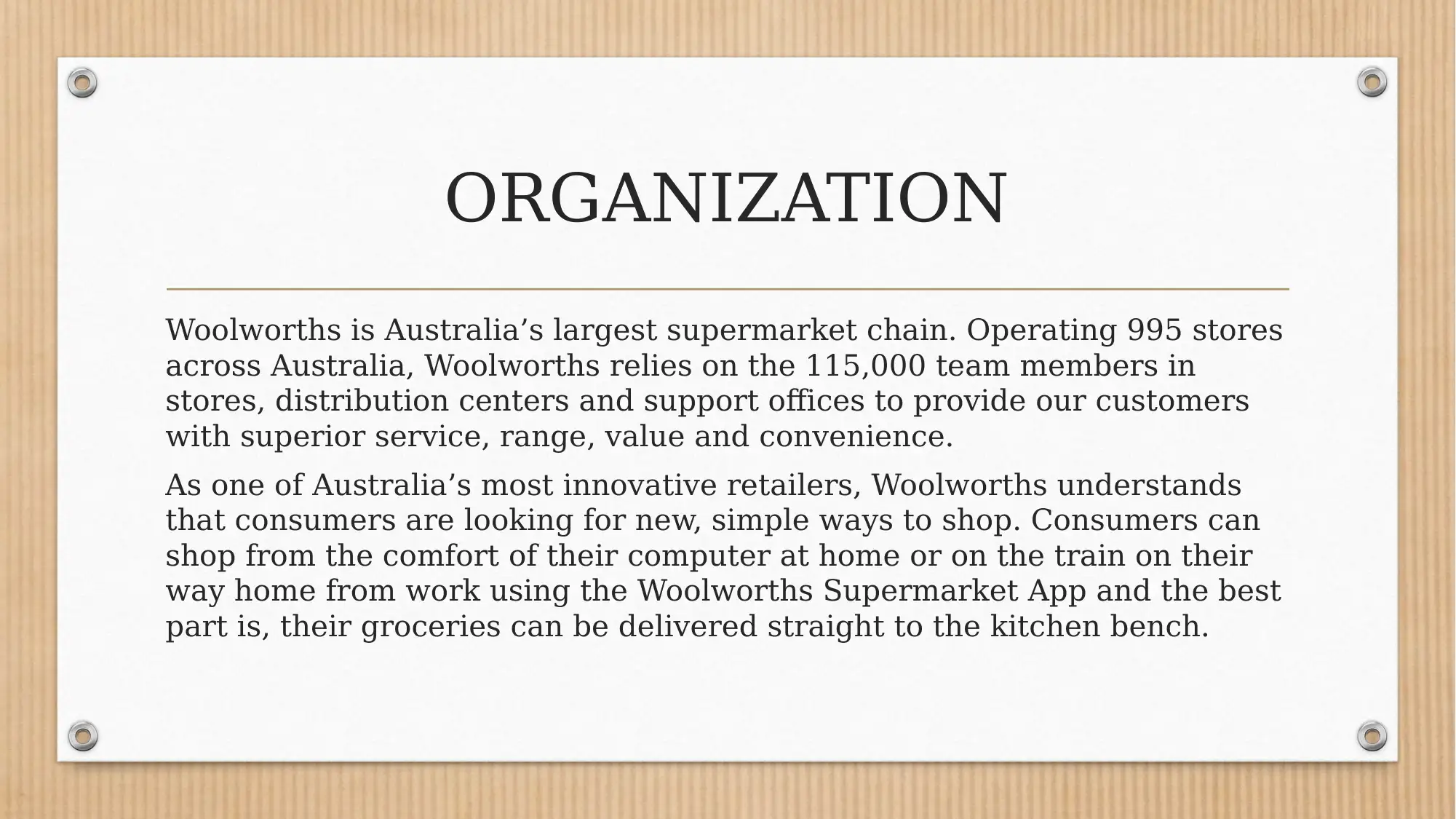
ORGANIZATION
Woolworths is Australia’s largest supermarket chain. Operating 995 stores
across Australia, Woolworths relies on the 115,000 team members in
stores, distribution centers and support offices to provide our customers
with superior service, range, value and convenience.
As one of Australia’s most innovative retailers, Woolworths understands
that consumers are looking for new, simple ways to shop. Consumers can
shop from the comfort of their computer at home or on the train on their
way home from work using the Woolworths Supermarket App and the best
part is, their groceries can be delivered straight to the kitchen bench.
Woolworths is Australia’s largest supermarket chain. Operating 995 stores
across Australia, Woolworths relies on the 115,000 team members in
stores, distribution centers and support offices to provide our customers
with superior service, range, value and convenience.
As one of Australia’s most innovative retailers, Woolworths understands
that consumers are looking for new, simple ways to shop. Consumers can
shop from the comfort of their computer at home or on the train on their
way home from work using the Woolworths Supermarket App and the best
part is, their groceries can be delivered straight to the kitchen bench.
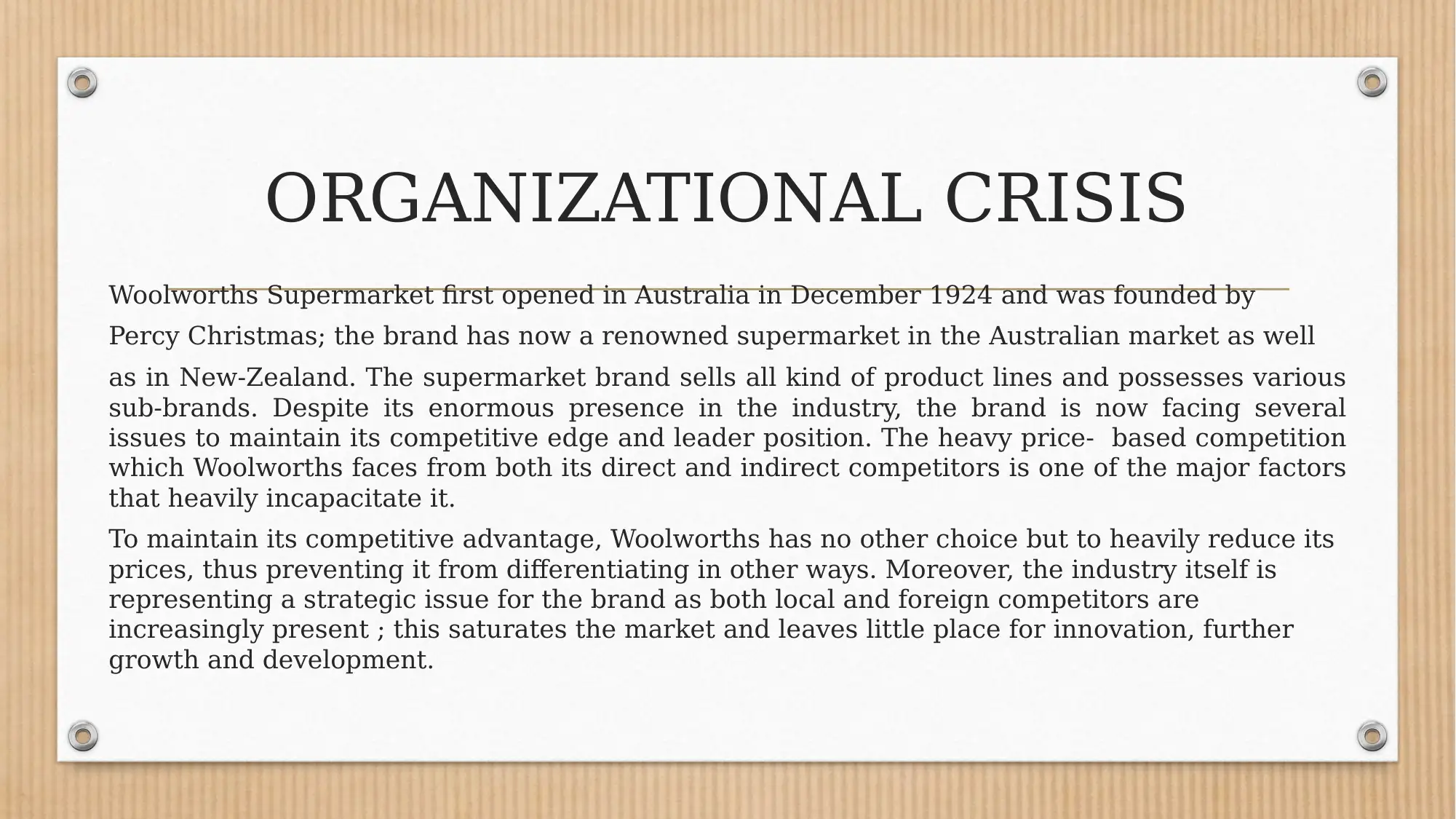
ORGANIZATIONAL CRISIS
Woolworths Supermarket first opened in Australia in December 1924 and was founded by
Percy Christmas; the brand has now a renowned supermarket in the Australian market as well
as in New-Zealand. The supermarket brand sells all kind of product lines and possesses various
sub-brands. Despite its enormous presence in the industry, the brand is now facing several
issues to maintain its competitive edge and leader position. The heavy price- based competition
which Woolworths faces from both its direct and indirect competitors is one of the major factors
that heavily incapacitate it.
To maintain its competitive advantage, Woolworths has no other choice but to heavily reduce its
prices, thus preventing it from differentiating in other ways. Moreover, the industry itself is
representing a strategic issue for the brand as both local and foreign competitors are
increasingly present ; this saturates the market and leaves little place for innovation, further
growth and development.
Woolworths Supermarket first opened in Australia in December 1924 and was founded by
Percy Christmas; the brand has now a renowned supermarket in the Australian market as well
as in New-Zealand. The supermarket brand sells all kind of product lines and possesses various
sub-brands. Despite its enormous presence in the industry, the brand is now facing several
issues to maintain its competitive edge and leader position. The heavy price- based competition
which Woolworths faces from both its direct and indirect competitors is one of the major factors
that heavily incapacitate it.
To maintain its competitive advantage, Woolworths has no other choice but to heavily reduce its
prices, thus preventing it from differentiating in other ways. Moreover, the industry itself is
representing a strategic issue for the brand as both local and foreign competitors are
increasingly present ; this saturates the market and leaves little place for innovation, further
growth and development.
⊘ This is a preview!⊘
Do you want full access?
Subscribe today to unlock all pages.

Trusted by 1+ million students worldwide
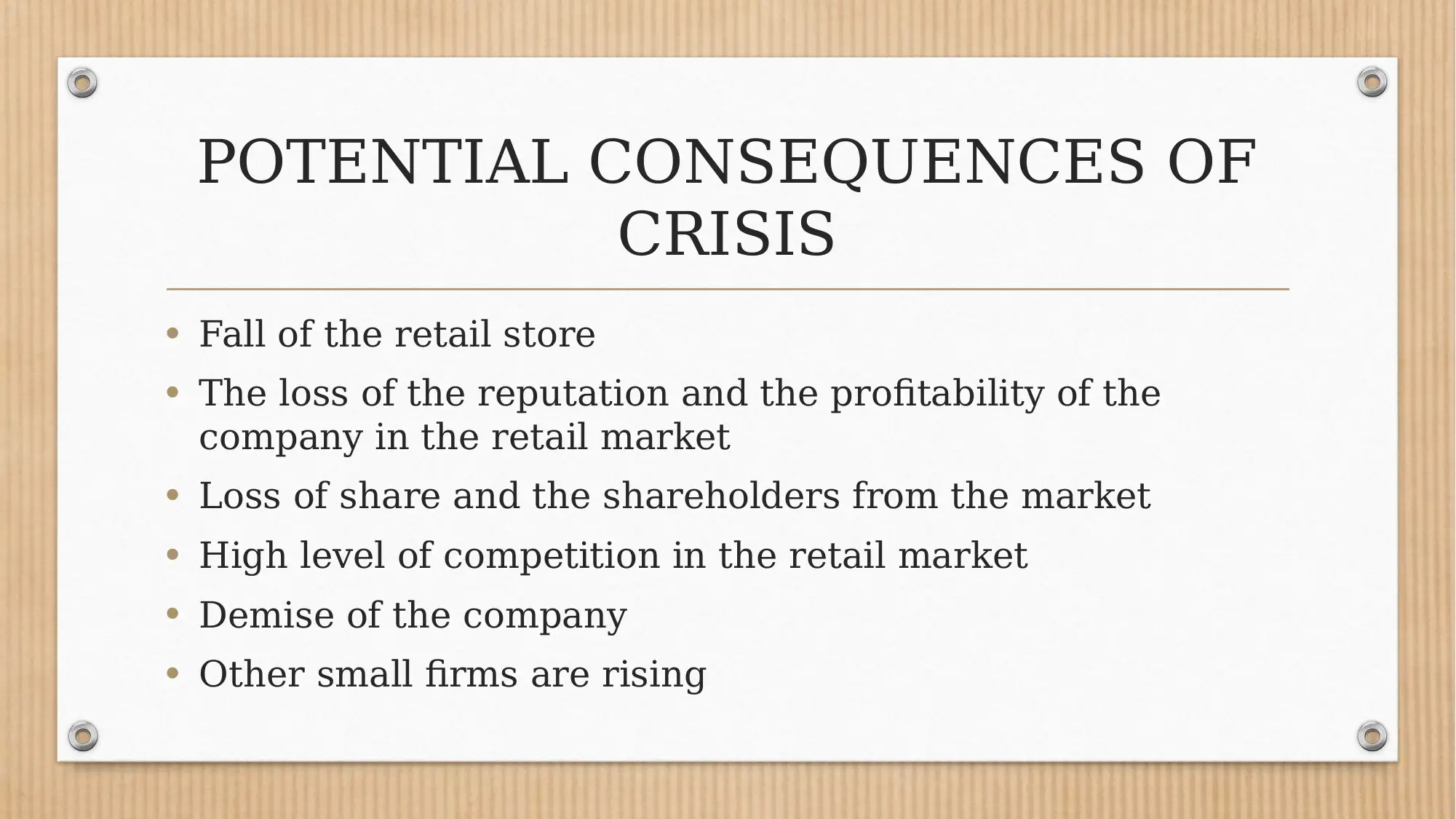
POTENTIAL CONSEQUENCES OF
CRISIS
• Fall of the retail store
• The loss of the reputation and the profitability of the
company in the retail market
• Loss of share and the shareholders from the market
• High level of competition in the retail market
• Demise of the company
• Other small firms are rising
CRISIS
• Fall of the retail store
• The loss of the reputation and the profitability of the
company in the retail market
• Loss of share and the shareholders from the market
• High level of competition in the retail market
• Demise of the company
• Other small firms are rising
Paraphrase This Document
Need a fresh take? Get an instant paraphrase of this document with our AI Paraphraser
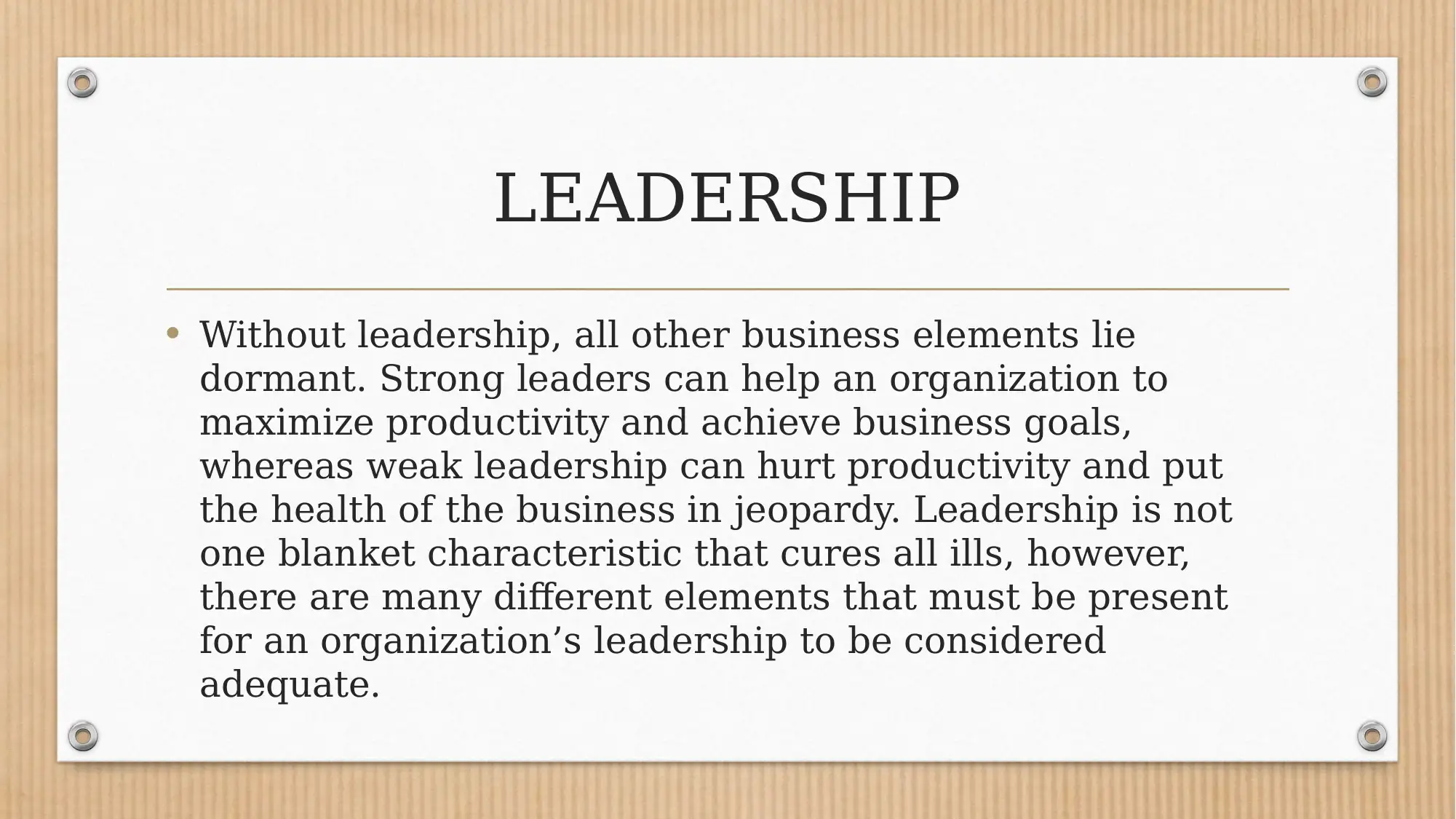
LEADERSHIP
• Without leadership, all other business elements lie
dormant. Strong leaders can help an organization to
maximize productivity and achieve business goals,
whereas weak leadership can hurt productivity and put
the health of the business in jeopardy. Leadership is not
one blanket characteristic that cures all ills, however,
there are many different elements that must be present
for an organization’s leadership to be considered
adequate.
• Without leadership, all other business elements lie
dormant. Strong leaders can help an organization to
maximize productivity and achieve business goals,
whereas weak leadership can hurt productivity and put
the health of the business in jeopardy. Leadership is not
one blanket characteristic that cures all ills, however,
there are many different elements that must be present
for an organization’s leadership to be considered
adequate.
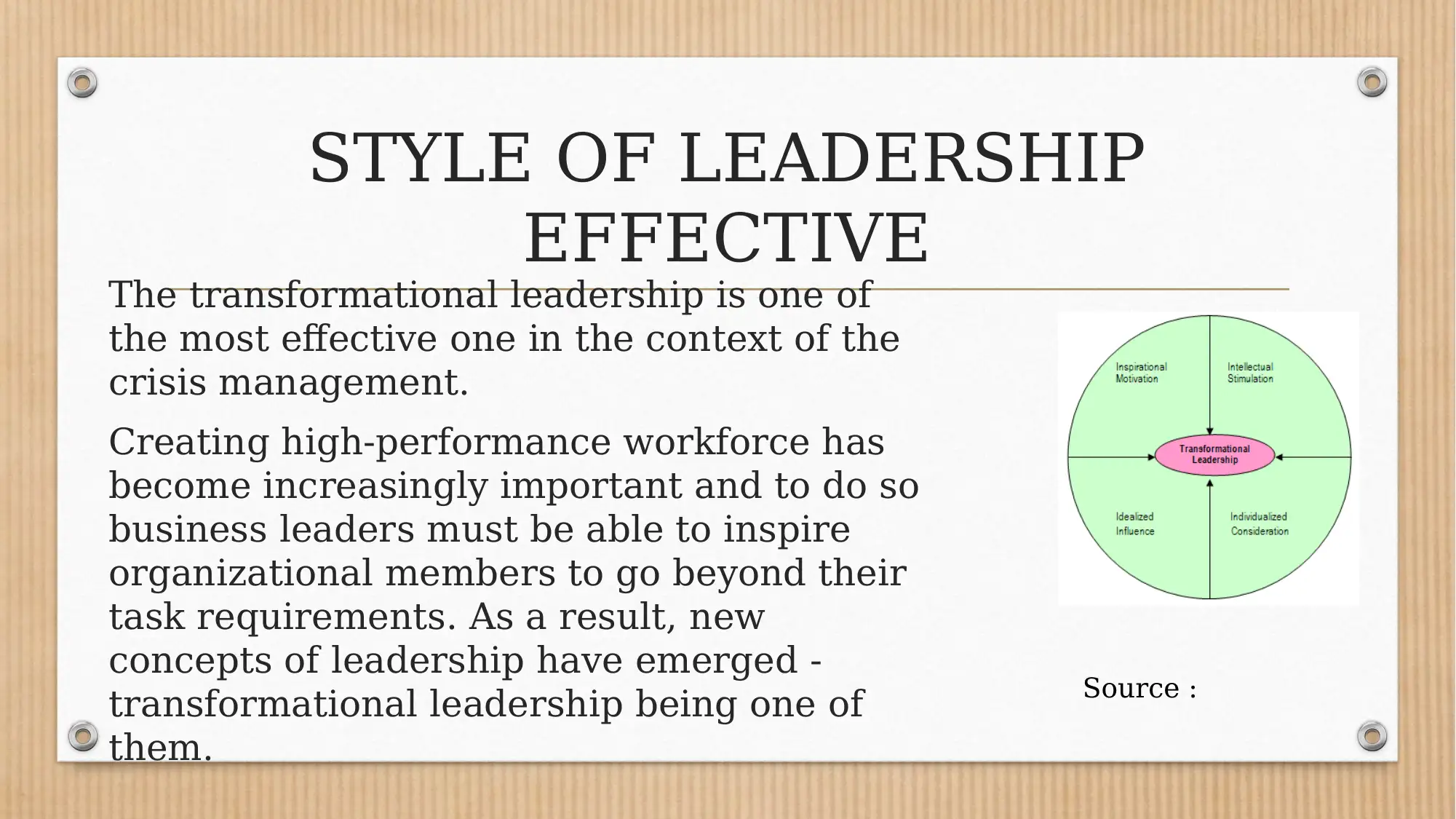
STYLE OF LEADERSHIP
EFFECTIVE
The transformational leadership is one of
the most effective one in the context of the
crisis management.
Creating high-performance workforce has
become increasingly important and to do so
business leaders must be able to inspire
organizational members to go beyond their
task requirements. As a result, new
concepts of leadership have emerged -
transformational leadership being one of
them.
Source :
EFFECTIVE
The transformational leadership is one of
the most effective one in the context of the
crisis management.
Creating high-performance workforce has
become increasingly important and to do so
business leaders must be able to inspire
organizational members to go beyond their
task requirements. As a result, new
concepts of leadership have emerged -
transformational leadership being one of
them.
Source :
⊘ This is a preview!⊘
Do you want full access?
Subscribe today to unlock all pages.

Trusted by 1+ million students worldwide
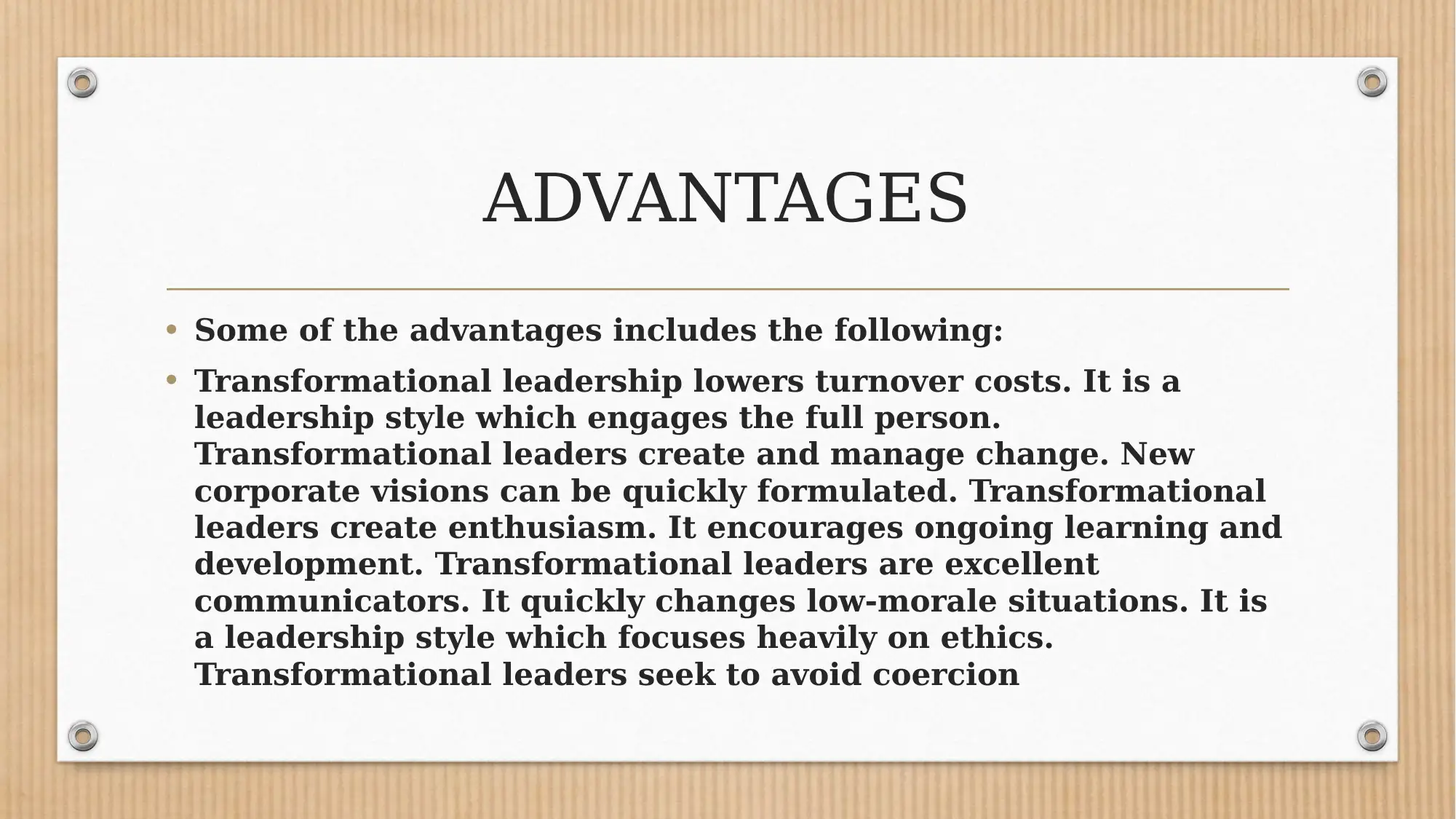
ADVANTAGES
• Some of the advantages includes the following:
• Transformational leadership lowers turnover costs. It is a
leadership style which engages the full person.
Transformational leaders create and manage change. New
corporate visions can be quickly formulated. Transformational
leaders create enthusiasm. It encourages ongoing learning and
development. Transformational leaders are excellent
communicators. It quickly changes low-morale situations. It is
a leadership style which focuses heavily on ethics.
Transformational leaders seek to avoid coercion
• Some of the advantages includes the following:
• Transformational leadership lowers turnover costs. It is a
leadership style which engages the full person.
Transformational leaders create and manage change. New
corporate visions can be quickly formulated. Transformational
leaders create enthusiasm. It encourages ongoing learning and
development. Transformational leaders are excellent
communicators. It quickly changes low-morale situations. It is
a leadership style which focuses heavily on ethics.
Transformational leaders seek to avoid coercion
Paraphrase This Document
Need a fresh take? Get an instant paraphrase of this document with our AI Paraphraser

DISADVANTAGES
• Transformational leaders can develop negative
outcomes. There must be continual communication
available. It requires constant and consistent
feedback. Transformational leaders need their
followers to agree with them. Risks taken through
transformational leadership can be disruptive. It can
lead to employee burnout. Transformational leaders
are not always detail-oriented
• Transformational leaders can develop negative
outcomes. There must be continual communication
available. It requires constant and consistent
feedback. Transformational leaders need their
followers to agree with them. Risks taken through
transformational leadership can be disruptive. It can
lead to employee burnout. Transformational leaders
are not always detail-oriented
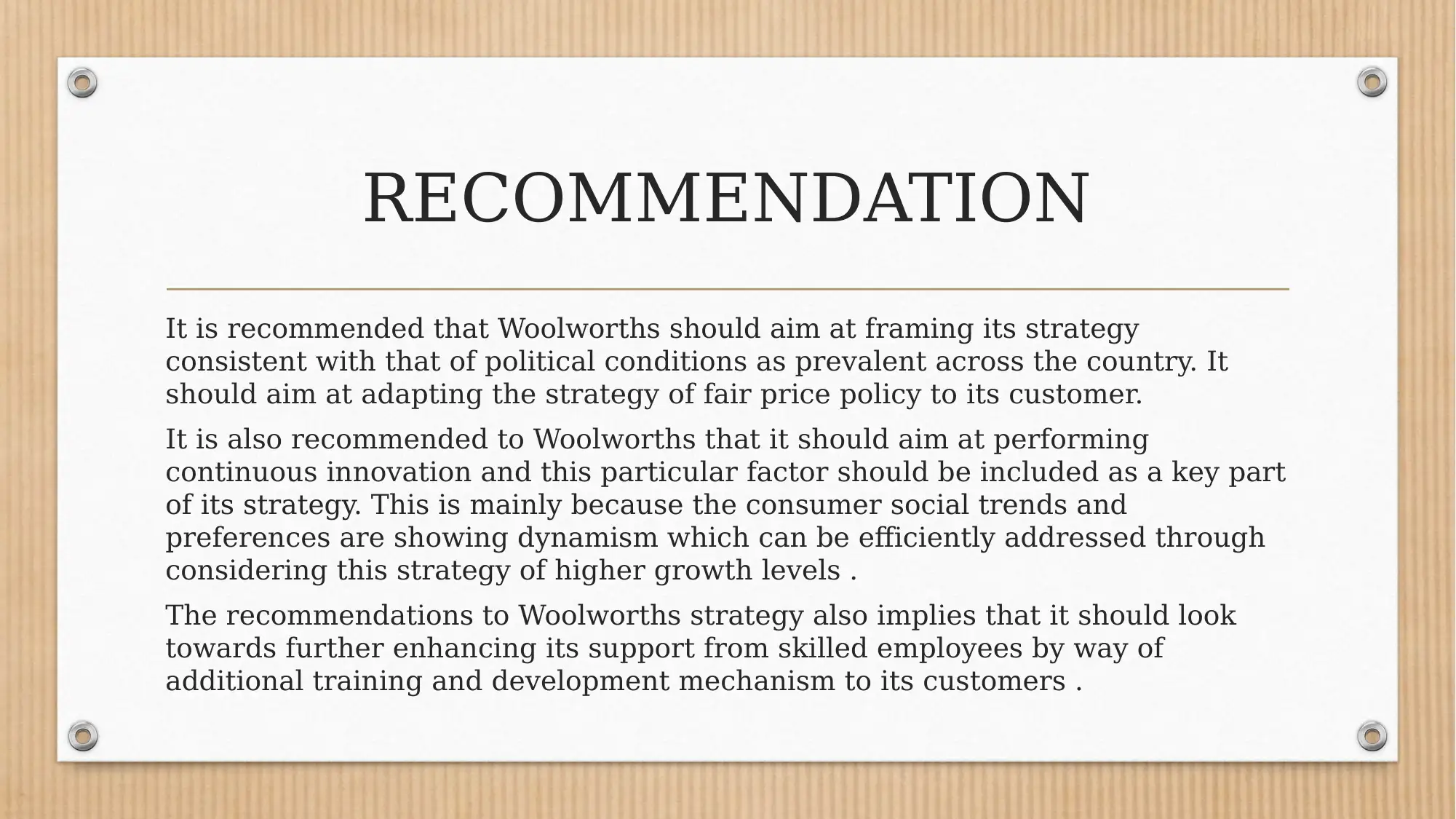
RECOMMENDATION
It is recommended that Woolworths should aim at framing its strategy
consistent with that of political conditions as prevalent across the country. It
should aim at adapting the strategy of fair price policy to its customer.
It is also recommended to Woolworths that it should aim at performing
continuous innovation and this particular factor should be included as a key part
of its strategy. This is mainly because the consumer social trends and
preferences are showing dynamism which can be efficiently addressed through
considering this strategy of higher growth levels .
The recommendations to Woolworths strategy also implies that it should look
towards further enhancing its support from skilled employees by way of
additional training and development mechanism to its customers .
It is recommended that Woolworths should aim at framing its strategy
consistent with that of political conditions as prevalent across the country. It
should aim at adapting the strategy of fair price policy to its customer.
It is also recommended to Woolworths that it should aim at performing
continuous innovation and this particular factor should be included as a key part
of its strategy. This is mainly because the consumer social trends and
preferences are showing dynamism which can be efficiently addressed through
considering this strategy of higher growth levels .
The recommendations to Woolworths strategy also implies that it should look
towards further enhancing its support from skilled employees by way of
additional training and development mechanism to its customers .
⊘ This is a preview!⊘
Do you want full access?
Subscribe today to unlock all pages.

Trusted by 1+ million students worldwide
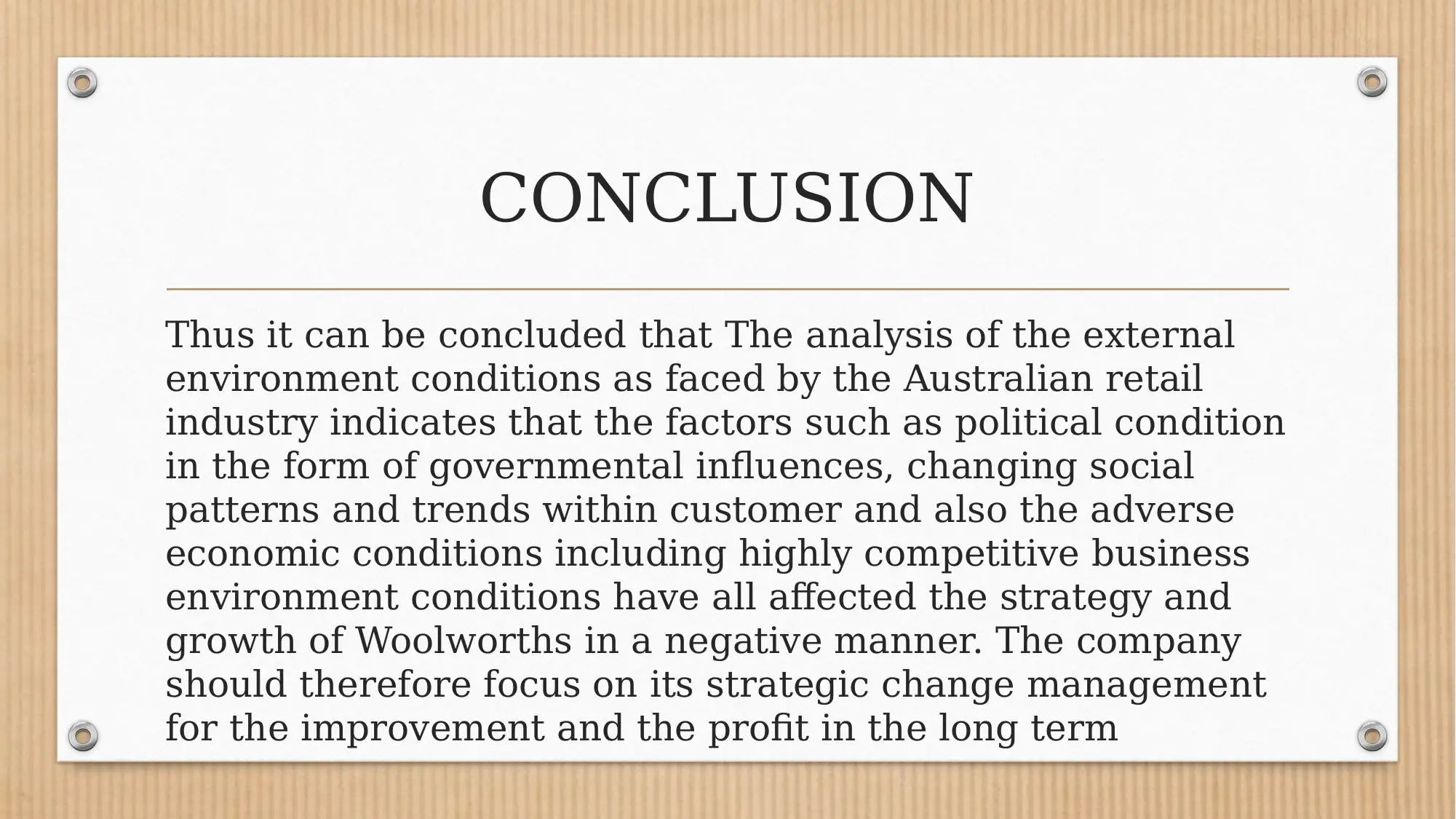
CONCLUSION
Thus it can be concluded that The analysis of the external
environment conditions as faced by the Australian retail
industry indicates that the factors such as political condition
in the form of governmental influences, changing social
patterns and trends within customer and also the adverse
economic conditions including highly competitive business
environment conditions have all affected the strategy and
growth of Woolworths in a negative manner. The company
should therefore focus on its strategic change management
for the improvement and the profit in the long term
Thus it can be concluded that The analysis of the external
environment conditions as faced by the Australian retail
industry indicates that the factors such as political condition
in the form of governmental influences, changing social
patterns and trends within customer and also the adverse
economic conditions including highly competitive business
environment conditions have all affected the strategy and
growth of Woolworths in a negative manner. The company
should therefore focus on its strategic change management
for the improvement and the profit in the long term
Paraphrase This Document
Need a fresh take? Get an instant paraphrase of this document with our AI Paraphraser
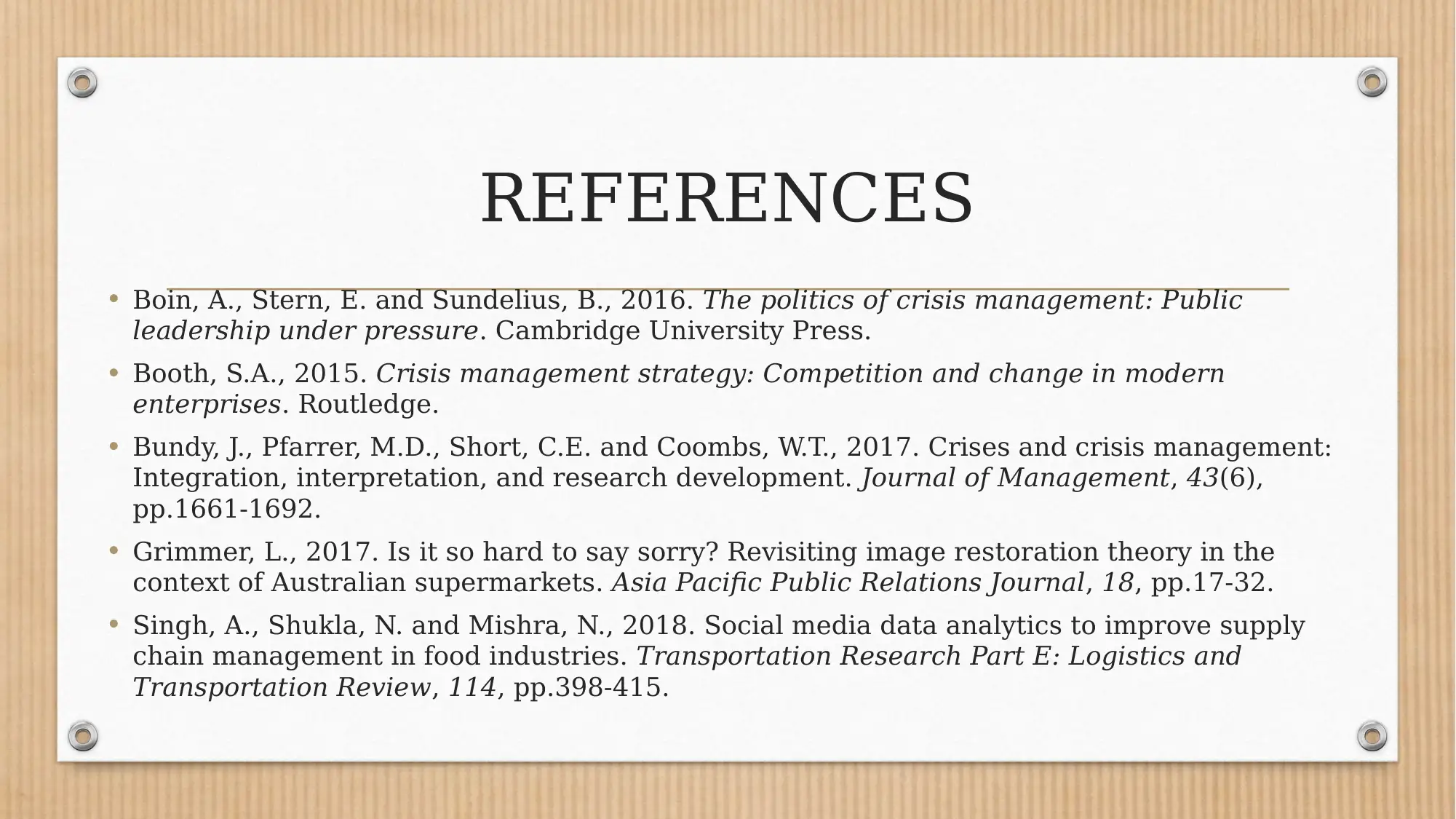
REFERENCES
• Boin, A., Stern, E. and Sundelius, B., 2016. The politics of crisis management: Public
leadership under pressure. Cambridge University Press.
• Booth, S.A., 2015. Crisis management strategy: Competition and change in modern
enterprises. Routledge.
• Bundy, J., Pfarrer, M.D., Short, C.E. and Coombs, W.T., 2017. Crises and crisis management:
Integration, interpretation, and research development. Journal of Management, 43(6),
pp.1661-1692.
• Grimmer, L., 2017. Is it so hard to say sorry? Revisiting image restoration theory in the
context of Australian supermarkets. Asia Pacific Public Relations Journal, 18, pp.17-32.
• Singh, A., Shukla, N. and Mishra, N., 2018. Social media data analytics to improve supply
chain management in food industries. Transportation Research Part E: Logistics and
Transportation Review, 114, pp.398-415.
• Boin, A., Stern, E. and Sundelius, B., 2016. The politics of crisis management: Public
leadership under pressure. Cambridge University Press.
• Booth, S.A., 2015. Crisis management strategy: Competition and change in modern
enterprises. Routledge.
• Bundy, J., Pfarrer, M.D., Short, C.E. and Coombs, W.T., 2017. Crises and crisis management:
Integration, interpretation, and research development. Journal of Management, 43(6),
pp.1661-1692.
• Grimmer, L., 2017. Is it so hard to say sorry? Revisiting image restoration theory in the
context of Australian supermarkets. Asia Pacific Public Relations Journal, 18, pp.17-32.
• Singh, A., Shukla, N. and Mishra, N., 2018. Social media data analytics to improve supply
chain management in food industries. Transportation Research Part E: Logistics and
Transportation Review, 114, pp.398-415.

THANK YOU
⊘ This is a preview!⊘
Do you want full access?
Subscribe today to unlock all pages.

Trusted by 1+ million students worldwide
1 out of 12
Related Documents
Your All-in-One AI-Powered Toolkit for Academic Success.
+13062052269
info@desklib.com
Available 24*7 on WhatsApp / Email
![[object Object]](/_next/static/media/star-bottom.7253800d.svg)
Unlock your academic potential
Copyright © 2020–2025 A2Z Services. All Rights Reserved. Developed and managed by ZUCOL.




